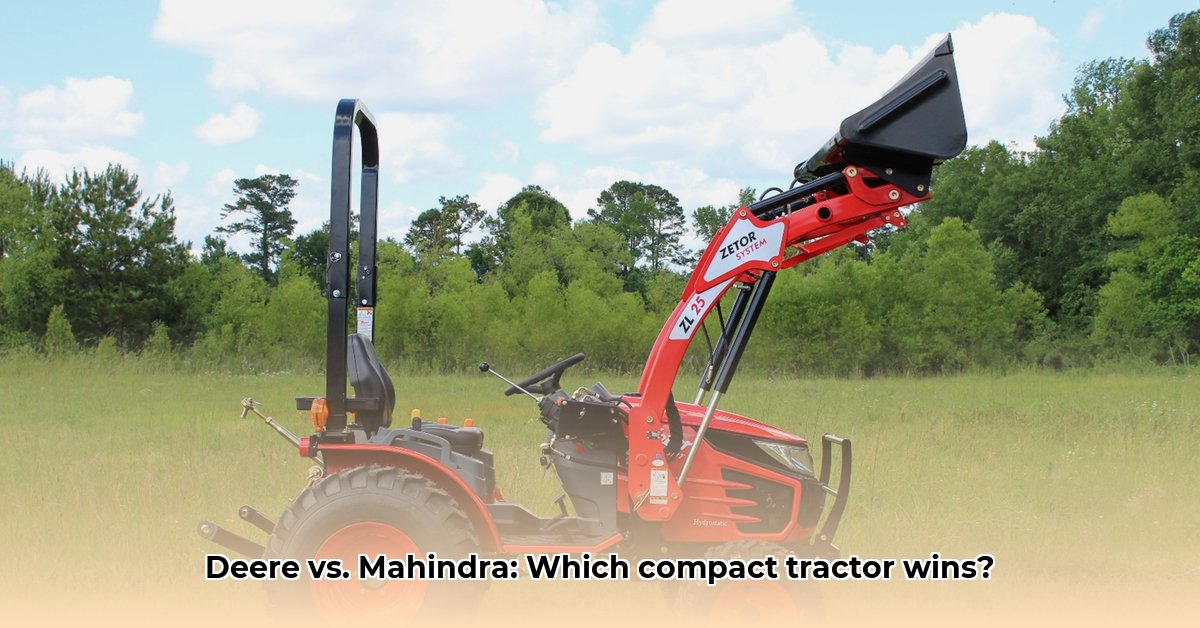
Choosing the right compact tractor is a crucial investment for sustainable agriculture or landscaping. This guide compares John Deere and Mahindra, two leading brands, to help you make an informed decision. We'll walk you through assessing your needs, exploring specific models, and comparing features to find the perfect fit for your operation. For additional options, consider exploring other brands like Kubota; check out this resource for used Kubota tractors.
Understanding Your Needs: Tailoring Your Tractor Choice
Before considering brands, define your specific needs. This process is similar to specifying requirements for any custom-built tool; the wrong tool makes the job harder and less efficient.
1. Operational Assessment:
- Land Size: The acreage determines the required horsepower. Smaller properties (under 5 acres) might benefit from a sub-compact tractor, while larger operations need more power.
- Primary Tasks: Moving hay bales, landscaping, or orchard maintenance all demand different functionalities. List your key tasks – multiple tasks often require a tractor with diverse implement capabilities.
- Budget: Establish a realistic budget encompassing the initial purchase price, necessary attachments, regular maintenance, and potential repairs. Overlooking long-term costs is a common mistake. Set a practical budget that works with your financial situation.
- Technological Proficiency: Assess your comfort level with technology. Some tractors offer advanced features like auto-steering; less tech-savvy users might prefer simpler controls.
2. Personalized Checklist:
Use this checklist to clarify your requirements. Rate the importance of each feature as High, Medium, or Low.
| Feature | Description | Importance (High/Medium/Low) |
|---|---|---|
| Horsepower | Power needed for your tasks (e.g., 20-40 HP) | |
| Loader Capacity | Weight-lifting capacity (e.g., 1,000 lbs) | |
| Attachments | Essential implements (e.g., mower, tiller, backhoe) | |
| Budget | Maximum purchase price | |
| Technology Level | Preferred level of automation and advanced features |
John Deere Compact Tractors: Premium Quality and Features
John Deere compact tractors consistently rank high in reliability and build quality. They offer a wide array of compatible implements and advanced technology features. However, this often comes with a higher purchase price.
Pros:
- Extensive Implement Compatibility: A wide range of attachments ensures versatility for various tasks, potentially reducing the need for multiple tools.
- Innovative Technology: Advanced hydraulics, intuitive controls, and optional technology packages like auto-steering can improve efficiency and ease of use.
- Strong Resale Value: John Deere tractors tend to retain their value well over time. This adds long-term economic advantages.
Cons:
- Higher Initial Cost: John Deere tractors typically command a premium price.
- Complex Features: The abundance of technologies can be challenging for first-time users. Proper training may be necessary for optimal usage.
Mahindra Compact Tractors: Value and Durability
Mahindra tractors offer a more affordable option while maintaining excellent durability and reliability. They are often the preferred choice for budget-conscious buyers.
Pros:
- Competitive Pricing: Mahindra tractors typically have a lower initial price point than comparable John Deere models.
- Robust Build: Known for their ability to handle heavy-duty tasks and withstand challenging conditions.
- User-Friendly Operation: Many users find Mahindra tractors simple and intuitive to operate.
Cons:
- Fewer Attachment Options: The range of compatible implements is generally smaller than John Deere's.
- Technology Level: Might lack the advanced features found in some John Deere models.
Head-to-Head Comparison: Key Specifications and Features
This table summarizes key differences (specific models and years will vary). Remember to check detailed specifications for the exact models you're considering.
| Feature | John Deere (e.g., 1 Series) | Mahindra (e.g., 1526) | Considerations |
|---|---|---|---|
| Horsepower | Variable | Variable | Match horsepower to your tasks; more isn't always better. |
| Price | Higher | Lower | Balance cost with features and long-term value; consider resale value. |
| Implement Variety | Extensive | More limited | Evaluate the range of tasks you need the tractor to perform. |
| Cab Options | Available on select models | Available on select models | Cab enhances comfort and safety but increases cost. |
| Transmission Type | Hydrostatic & Gear | Hydrostatic & Gear | Hydrostatic transmissions are generally easier to operate, particularly for beginners. |
Choosing the Right Attachments: Essential Implements
Selecting appropriate attachments significantly expands your tractor's capabilities, turning it into a versatile workhorse.
- Front-End Loaders: Crucial for moving materials, loading, and general material handling.
- Backhoes: For digging and trenching.
- Tillers: For soil preparation and cultivation.
- Mowers: For landscaping and field maintenance.
- Other Implements: Snow blowers, post hole diggers, and numerous other specialized tools.
Always confirm compatibility between the tractor and attachments before purchasing.
Maintenance and Long-Term Costs: A Crucial Consideration
Regular maintenance is key to extending your tractor's lifespan and avoiding expensive repairs. Consult the owner's manual for recommended service intervals. Factor in the cost of routine maintenance, potential repairs, and parts replacement when budgeting.
Conclusion: Making Your Informed Decision
- Prioritize Features: Identify the essential features for your operation.
- Adhere to Your Budget: Avoid overspending; stay within your financial means.
- Test Drive (if possible): Experience both brands firsthand before committing.
- Seek Expert Advice: Consult your local John Deere and Mahindra dealers for personalized recommendations. They're invaluable resources for both purchasing and ongoing maintenance.
Choosing the right compact tractor necessitates careful consideration of your specific needs, budget, and long-term maintenance. This guide helps navigate the decision-making process, ultimately leading to a more informed and suitable choice.